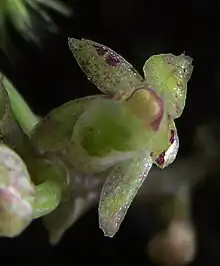Drymoanthus
Drymoanthus, commonly known as midget orchids[2] is a genus of epiphytic orchids in the family Orchidaceae. Plants in this genus are relatively small and unbranched with thick roots, narrow crowded leaves and small scented green flowers with a white labellum. There are four species, found in Australia, New Zealand and New Caledonia.
| Drymoanthus | |
|---|---|
 | |
| Close up of Drymoanthus adversus flower | |
| Scientific classification | |
| Kingdom: | Plantae |
| Clade: | Tracheophytes |
| Clade: | Angiosperms |
| Clade: | Monocots |
| Order: | Asparagales |
| Family: | Orchidaceae |
| Subfamily: | Epidendroideae |
| Tribe: | Vandeae |
| Subtribe: | Aeridinae |
| Genus: | Drymoanthus Nicholls[1] |
Description
Orchids in the genus Drymoanthus are small, unbranched, epiphytic herbs with thick roots, a thin stem, narrow, crowded, thin, leathery leaves and small, short-lived green flowers with a white labellum. The sepals and petals are similar to each other although the petals are slightly shorter. The labellum is white, boat-shaped, unlobed and stiffly attached to the column.[2][3]
Taxonomy and naming
The genus Drymoanthus was first formally described in 1943 by William Henry Nicholls and the description was published in The Victorian Naturalist.[4][5]
Four species are accepted by the World Checklist of Selected Plant Families:[1]
See also
References
- "Drymoanthus". World Checklist of Selected Plant Families (WCSP). Royal Botanic Gardens, Kew.
- Jones, David L. (2006). A complete guide to native orchids of Australia including the island territories. Frenchs Forest, N.S.W.: New Holland. p. 435. ISBN 1877069124.
- D.L.Jones; T.Hopley; S.M.Duffy (2010). "Drymoanthus". Australian Tropical Rainforest Orchids. Centre for Australian National Biodiversity Research (CANBR), Australian Government. Retrieved 30 May 2021.
- "Drymoanthus". APNI. Retrieved 24 December 2018.
- Nicholls, William Henry (1942). "A new genus of Australian orchids". The Victorian Naturalist. 59: 173–175. Retrieved 24 December 2018.
External links
 Media related to Drymoanthus at Wikimedia Commons
Media related to Drymoanthus at Wikimedia Commons